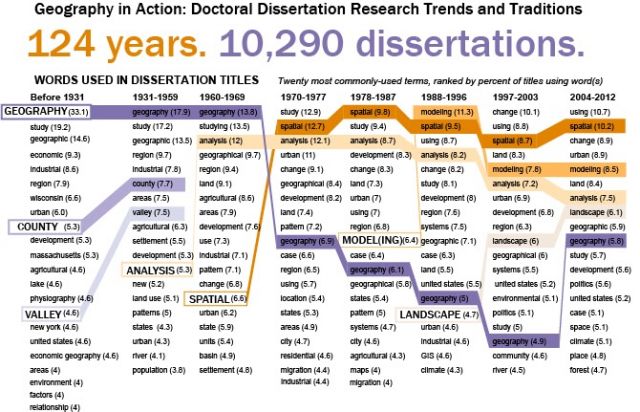In lab group meetings we have been discussing the evolution and future of Spatial Data Science as a discipline.
Therefore when I recently stummbled upon a article about a reserarch project looking at the evolution of Geography based on a database of Doctoral Dissertation Titles, I couldn't help but be excited, and intrigued by the connection.
This reasearch from Kent University Professors David Kaplan and Jennifer Mapes is also reminiscent of Kelly Lab's own Shufei Lei's recent work analyzing and mapping textual data in the context of ecological systems and adapative managment!
Just like spatial data science, Geography as a discipline has struggled with defining its' complex identity, its principles and concepts spanning and borrowing from several established discipinces.
From the article:
"Geography is a relatively young discipline in terms of university academics, and for much of its history, geographers have struggled to define what exactly the discipline includes, said Keith Woodward, an assistant professor of geography at the University of Wisconsin at Madison.
So for a historical perspective, this type of database would be helpful looking at a timeline of how geographers defined their field, Woodward said."
The database is a compliation of 10,290 dissertations ranging back to the late 1800's with the goal of understanding the trends, concentrations, and expansion of Geography as a discipline over time.
Although currently unpublished (look out for an article in Geographical Review early 2015) there are a few preliminary findings and possibilites that sound immensly interesting:
"The study maps which universities have high percentages of dissertations focused on domestic or foreign regions, and also shifts in which regions of the world were popular topics for dissertations."
"A database of dissertations could provide a glimpse into what academics are interested in and how their focuses shifts as de-colonization and globalization occurs, Woodward said."
"Much of the focus so far has been on the words within the dissertation titles and how they’re used. Geographers today like to explain the field as a study of space and place, Mapes said. But those words didn’t become popular in dissertations until the 1960s."
Read the full article here and look out for an article in Geographical Review early 2015.

